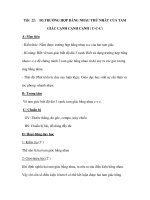Eabc292 e257 d3 f6 efde8 d6 fca788 c
Bạn đang xem bản rút gọn của tài liệu. Xem và tải ngay bản đầy đủ của tài liệu tại đây (140.86 KB, 3 trang )
INTRODUCTION
Ultraviolet and visible absorptions of organic compounds are characteristic of
absorbing systems that consist of a so-called chromophore group and the auxochromic groups
bonded to it, rather than the chemical structure of the molecule as a whole.
For example, the ultraviolet absorption maximum of the cholestadienone isomer (I) is
close to that, of (II), but entirely different from those of the other isomers, (III), (IV),
and (V)o However, it is very close to the absorption maximum of a nonsteroidal,
4-methyl-6-(2,6,6-trimethyl-2-cyclohexenyl)-3,5-hexadien-2-one (VI). This is natural
because the absorbing system is the same in (I), (II), and (VI), but is quite different
from those of (III), (IV), and (V)0
(I) cholesta-4,6-dien-3-one
(II)
*2Sf 277m^
*max* 285m^ <lo§e 4'4>
(III)
cholesta-1,4-dien-3-one
(IV)
(VI)
X
maxH
242ra
^ (loB£4'°)
(1
°S£ 4'4)
cholesta-4,7-dien-3-one
X^XH 238my (loge 4.2)
AjJOH 245my (logs 4.2)
(V) cholesta-7,14-dien-3-one
cholesta-3,5-dien-7-one
4-methyl-6-(2,6,6-trimethyl-2cyclohexenyl)-3,5-hexadien-2-one
xJaJH 285my (loge 4.2)
Studies of ultraviolet and visible absorption spectra started long before the study
of infrared absorption spectra, and a far larger number of spectral measurements is
available. Still, they have not been fully utilized for the identification of organic
compounds and the most important reason for this state of affairs is that these data have
not been organized from the point of view of the absorbing system, as outlined above.
Having realized the need for such a collection of data, the writer collected,
classified, and published such data as a part of "Yuki Kagaku Teisu Binran," a volume in
"Dai Yuki Kagaku" (Series of Comprehensive Organic Chemistry, 25 vols. with an index
volume, Asakura Shoten, Tokyo, 1960-1963).
In that publication, rules were proposed for notation and for the order of the absorbing systems. The collection of data was certainly useful in utilizing ultraviolet and
visible absorption spectra, but it included only a table for identifying absorption maxima
from absorbing systems and no table in which the absorbing systems could be found from
the absorption maxima, which would be the most convenient method for structural identification.
This shortcoming has now been corrected, and the revised and enlarged version that has
been compiled for the present edition does contain a tabulation according to absorption
maxima.
Table I is a list from which absorption maxima can be found from the absorbing systems,
i.e., from the chemical structure. In general, the absorption of strongest intensity in a
range of about 50my in wavelength was taken as the absorption maximum. Consequently, the
distance between two absorption maxima is usually more than 50my.
This table is used in the following manner. To look for the absorption maximum of
cholesta-4,6-dien-3-one (I), we look under the absorbing system
O' C~C' C~-C' C-C
'i *±
The order of the arrangement of absorbing systems is explained in detail under "Explanation
of Notation and Arrangement." The desired absorbing system can be found directly from
Table I by following this order of arrangement, or the chromophore group in this absorbing system (O!C-C'.C—C'.C in the above example) can be found from the "List of Chromophores"
from which the compound number of (0:C)(C:C)2 is found as 772-831.
Table II is a reverse index of Table I. It is a list of absorbing systems to be
found from the wavelengths of absorption maxima.
Ultraviolet and visible absorptions of organic compounds can be determined approximately from the absorbing system, but the solvent used and measurement error must also be
taken into account. Consequently, it is better to examine the wavelength regions around
the desired wavelength.
For example, if an unsaturated ketone having no substituent other than one keto
group has an absorption maximum at 285my (loge 4.42) in ethanol, the following absorption
maxima in a range of 285±5my can be found from Table II.
(0:C)(C:C)
<0:C)(CrC)2
loge
no .
loge
no.
4.0
4.0
717
756
4.2
3.9
4.3
794
812
828
4.4
3.3
727
757
4.4
804
-2my = 283my
-Imp = 284my
±0my = 285my
4.4
815
4.1
3.8
648
713
4.3
4.2
4.4
797
806
807
+lmy = 286my
4-2my = 287my
4.3
719
4.4
4.4
4.5
4.4
4.4
4.2
783
827
799
807
808
793
795
805
813
^•max.
-5my = 280my
-4my = 281my
-3my = 282my
+3my = 288my
-f-4my = 289my
+5my = 290my
4.1
4.1
(OrC)(CrC)3
(OrC)(CrC)6
loge
no.
loge
no .
4.1
850
4.1
869
Examination of the absorbing system of these compounds from compound numbers in Table
I shows that the (0:C)(C:C) group, and compounds 783, 827, and 828 in the (OrC)(CrC)2 group
are not the desired systems, because they have auxochromes
joined to the chromophore. The (OrC)(CrC)^ group has a
stronger absorption maximum at 393my (loge 4.8) and is
not the desired system. Further, compounds 793, 794, 795,
797, and 799 of the (0:C)(CrC)2 group are dienal and are
therefore unsuitable. Consequently, the absorbing systems
that remain are those which include compounds 804, 805, 806,
807, 808, 812, 813, and 815, i.e., a dienone of
°:9"°:C~~°:C type, with two or three
alkyl auxochromes, or a trienone of type (VII) with a steric hindrance like compound 850.
These conclusions are based on the chemical observation that there is no hetero-atom
in the molecule other than the oxygen atom in the keto group and on spectral observations
of the absorption maximum and intensity, but the possible absorbing systems can be further
narrowed by comparing ultraviolet absorption curves.
Grateful acknowledgement is made to Dorothy U. Mizoguchi for her cooperation in preparing the manuscript.
Kenzo Hirayama









